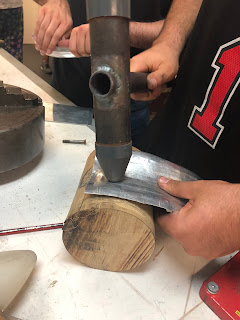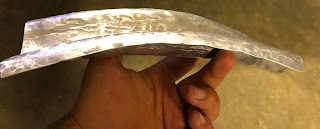March 28th, 2018
Aim: To create an Aluminium Tray using techniques shown to us in class
Objectives:
- Smooth even finish
- Minimal Burs and an even smooth edge
- Must create an tray identical to designated group member
- Mustn't have gaps in between the to trays when aligned and the base must be flat not rounded
- Stand out from the rest
Process:
The first thing in creating the aluminium tray was to create a mould in which the tray will be formed on.Using a CNC machine a template which was already created in the system was cut out of a thin piece of PLY to provide the final shape of the tray.Using this template the design was traced onto pre-cut plywood and cut out and shaped using a disc sander.Once i achieved the correct curves i then traced the mould onto the piece of aluminium, leaving ample room to achieve a 10mm height on the tray
Once i had traced the mould I then cut out the trays shape using aviation snips.Then using the two moulds i sandwiched the aluminium between the them ensuring they are even on both sides and then placed it into the vice clamp.Using a plastic mallet I began to slowly and carefully form the aluminium to suit the mould of the tray.This process followed around the whole tray until i achieved the required tray look i needed.
The hammering process was very challenging due to the fact that each hit was required to be pin pointed and not hit to hard otherwise it would have ruined the shape.Hence, in order to achieve a greater look it took me longer then expected.
Then after I was happy with the shape of the tray i began to smooth out the edges, curves and base of the tray to provide a nice smooth and neat finish.After sanding, planishing and hours of tedious work i finally finished and produce the below tray masterpiece.
Our tray didn't match 100% probably only 95 % but it was pretty good for our first time considering we had never done that kind of stuff before



































